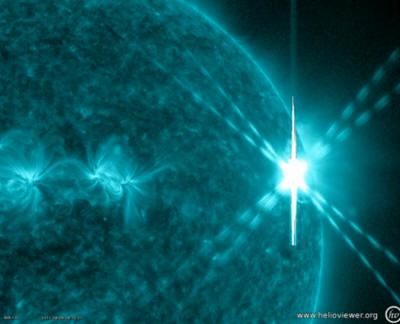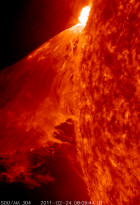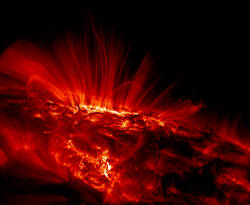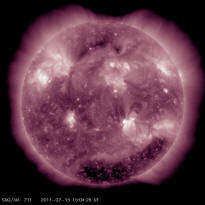|

by Clara Moskowitz
SPACE.com Senior Writer
09 August 2011
from
Space Website

This still
from a video taken by NASA's Solar Dynamics Observatory
shows the August 8,
2011 solar flare as it appeared in the ultraviolet range of the
light spectrum.
The flare registered
as an X6.9 class sun storm, the largest of the Solar Cycle 24.
CREDIT: NASA/SDO/GSFC
An extremely powerful solar flare, the
largest in over four years, rocked the sun early Tuesday (August 9),
but is unlikely to wreak any serious havoc here on Earth, scientists
say.
"It was a big flare," said Joe
Kunches, a space scientist with the National Oceanic and
Atmospheric Administration (NOAA)'s Space Weather Prediction
Center.
"We lucked out because the site of
the eruption at the sun was not facing the Earth, so we will
probably feel no ill effects."
Today's solar flare began at 3:48 a.m.
EDT (07:48 GMT), and was rated a class X6.9 on the three-class scale
scientists use to measure the strength of solar flares.
The
strongest type of solar eruption is class X, while class C
represents the weakest and class M flares are medium-strength
events. (Sun's Wrath
- Worst Solar Storms in History)
The flare is the largest one yet in the sun's current cycle, which
began in 2008 and is expected to last until around 2020.
Solar activity waxes and wanes over an
11-year sun weather cycle, with the star currently heading toward a
solar maximum in 2013.
"This flare had a GOES X-ray
magnitude of X6.9, meaning it was more than 3 times larger than
the previous largest flare of this solar cycle - the X2.2 that
occurred on Feb 15, 2011," scientists with NASA's Solar Dynamics
Observatory, a space observatory that monitors the sun, wrote in
an update.
Before the February 15 storm, the largest
recent solar flare occurred in December 2006, when an X9-class solar
storm erupted from the sun.
Solar flares occur when magnetic field lines on the sun get tangled
up into knots, building potential energy until they reach a tipping
point. Then, that energy is converted into heat, light and the
motion of charged particles.
While all
X-class solar eruptions are major events, they pose the
greatest threat to Earth when they are aimed directly at the planet.
During those events the sun often releases a cloud of plasma called
a coronal mass ejection into space, and sometimes toward Earth.
This ejection hurls charged particles
that can damage satellites, endanger astronauts in orbit, and
interfere with power systems, communications and other
infrastructure on the planet.

Major Solar Flare
August 9, 2011
Today's solar flare, and resulting
coronal mass ejection (CME) was not aimed at us, however.
Stunning
Photos of Solar Flares & Sun Storms
 |
 |
 |
|
Sun's
Twisting Plasma Tentacle.
Credit: NASA/SDO/GSFC.
NASA's
Solar Dynamics Observatory spacecraft captured this
eruption from March 19, 2011 as a prominence became
unstable and blasted into space with a distinct twisting
motion.
|
Monster
Prominence.
Credit: NASA/SDO.
NASA's Solar Dynamics
Observatory captured this view of a powerful M3.6 Class
solar flare on Feb. 24, 2011 during a 90-minute sun
storm. NASA scientists called the display a "monster
prominence" that kicked up a huge plasma wave.
|
Blazin'.
Credit: TRACE Project, NASA.
This ultraviolet image
of the sun shows large sunspot group AR 9169 as the
bright area near the horizon. The relatively cool dark
regions have temperatures of thousands of degrees
Celsius, in contrast to the bright glowing gas flowing
around the sunspots, which have a temperature of over
one million degrees Celsius.
Large sunspot group AR 9169
moved across the sun during September 2000.
|
 |
 |
 |
|
Sun's Active
Region 1158 Solar Flare
Credit: NASA/SDO/GFSC
An X2.2
flare erupted from the sun's active region 1158 (at
lower right) at about 0150 UT or 8:50 pm ET on Feb. 14,
2011. |
Bastille Day
Solar Flare
Credit: NASA
The "Bastille Day" solar flare as
seen by SOHO's EIT instrument in the 195 Ň emission line. |
Solar C7
Flare in Ultraviolet
Credit: NASA/SDO
The Solar Dynamics
Observatory captured this video of the C7 flare of June
20, 2011 in extreme ultraviolet wavelength at 335 Ň. |
"Because of its position the CME is
going to shoot out into space and not be Earth-directed, and we
donít expect any big geomagnetic storm with this," Kunches told
SPACE.
"We did luck out. If this would have
happened a week ago, who knows?"
However, some VLF and HF radio
communications blackouts have been reported, according to
Spaceweather, a website that monitors space weather events.
Whatever particles do head our way should reach us in a few days.
Video
August 9 Solar Flare Briefly Knocks Out HF Radio
"The cloud will probably miss
Earth," SpaceWeather wrote. "At this time, however, we cannot
rule out a glancing blow from the flank of the CME on or about
August 11th."
The plus side of such a collision is
often unusually
spectacular auroras, or Northern and Southern
Lights, which occur when charged particles interact with Earth's
magnetic field.
|








